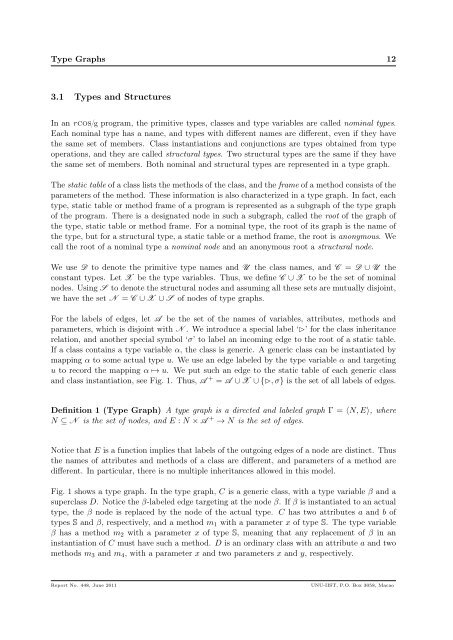A Graph-Based Generic Type System for Object-Oriented Programs
A Graph-Based Generic Type System for Object-Oriented Programs
A Graph-Based Generic Type System for Object-Oriented Programs
Create successful ePaper yourself
Turn your PDF publications into a flip-book with our unique Google optimized e-Paper software.
<strong>Type</strong> <strong>Graph</strong>s 123.1 <strong>Type</strong>s and StructuresIn an rcos/g program, the primitive types, classes and type variables are called nominal types.Each nominal type has a name, and types with different names are different, even if they havethe same set of members. Class instantiations and conjunctions are types obtained from typeoperations, and they are called structural types. Two structural types are the same if they havethe same set of members. Both nominal and structural types are represented in a type graph.The static table of a class lists the methods of the class, and the frame of a method consists of theparameters of the method. These in<strong>for</strong>mation is also characterized in a type graph. In fact, eachtype, static table or method frame of a program is represented as a subgraph of the type graphof the program. There is a designated node in such a subgraph, called the root of the graph ofthe type, static table or method frame. For a nominal type, the root of its graph is the name ofthe type, but <strong>for</strong> a structural type, a static table or a method frame, the root is anonymous. Wecall the root of a nominal type a nominal node and an anonymous root a structural node.We use D to denote the primitive type names and U the class names, and C = D ∪ U theconstant types. Let X be the type variables. Thus, we define C ∪ X to be the set of nominalnodes. Using S to denote the structural nodes and assuming all these sets are mutually disjoint,we have the set N = C ∪ X ∪ S of nodes of type graphs.For the labels of edges, let A be the set of the names of variables, attributes, methods andparameters, which is disjoint with N . We introduce a special label ‘⊲’ <strong>for</strong> the class inheritancerelation, and another special symbol ‘σ’ to label an incoming edge to the root of a static table.If a class contains a type variable α, the class is generic. A generic class can be instantiated bymapping α to some actual type u. We use an edge labeled by the type variable α and targetingu to record the mapping α ↦→ u. We put such an edge to the static table of each generic classand class instantiation, see Fig. 1. Thus, A + = A ∪ X ∪ {⊲, σ} is the set of all labels of edges.Definition 1 (<strong>Type</strong> <strong>Graph</strong>) A type graph is a directed and labeled graph Γ = 〈N, E〉, whereN ⊆ N is the set of nodes, and E : N × A + → N is the set of edges.Notice that E is a function implies that labels of the outgoing edges of a node are distinct. Thusthe names of attributes and methods of a class are different, and parameters of a method aredifferent. In particular, there is no multiple inheritances allowed in this model.Fig. 1 shows a type graph. In the type graph, C is a generic class, with a type variable β and asuperclass D. Notice the β-labeled edge targeting at the node β. If β is instantiated to an actualtype, the β node is replaced by the node of the actual type. C has two attributes a and b oftypes S and β, respectively, and a method m 1 with a parameter x of type S. The type variableβ has a method m 2 with a parameter x of type S, meaning that any replacement of β in aninstantiation of C must have such a method. D is an ordinary class with an attribute a and twomethods m 3 and m 4 , with a parameter x and two parameters x and y, respectively.Report No. 448, June 2011UNU-IIST, P.O. Box 3058, Macao
















